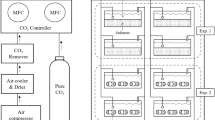Abstract
The salinity tolerance of two dominant Antarctic planktic copepods (Calanus propinquus and Metridia gerlachei) was tested over a range from 34 to 85 PSU and compared with that of sympagic turbellarians. The copepods survived only at a salinity of 34, higher salinities causing death within days. The turbellarians survived at salinities up to 75. The data imply that C. propinquus and M. gerlachei will not survive incorporation into newly forming sea ice because of the increasing brine salinity in new ice.
Similar content being viewed by others
Author information
Authors and Affiliations
Additional information
Received: 27 January 1998 / Accepted: 11 April 1998
Rights and permissions
About this article
Cite this article
Gradinger, R., Schnack-Schiel, S. Potential effect of ice formation on Antarctic pelagic copepods: salinity induced mortality of Calanus propinquus and Metridia gerlachei in comparison to sympagic acoel turbellarians. Polar Biol 20, 139–142 (1998). https://doi.org/10.1007/s003000050288
Issue Date:
DOI: https://doi.org/10.1007/s003000050288




